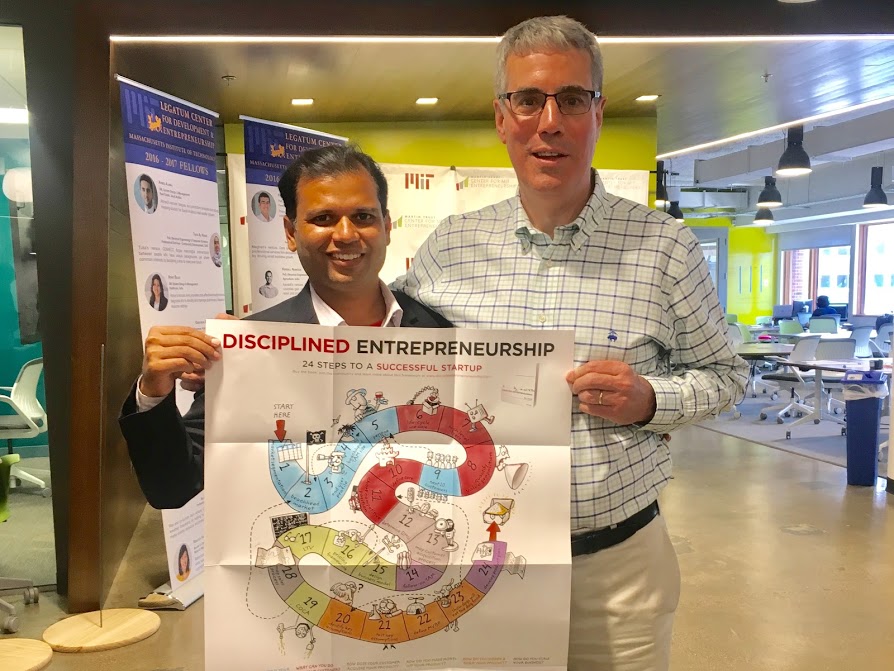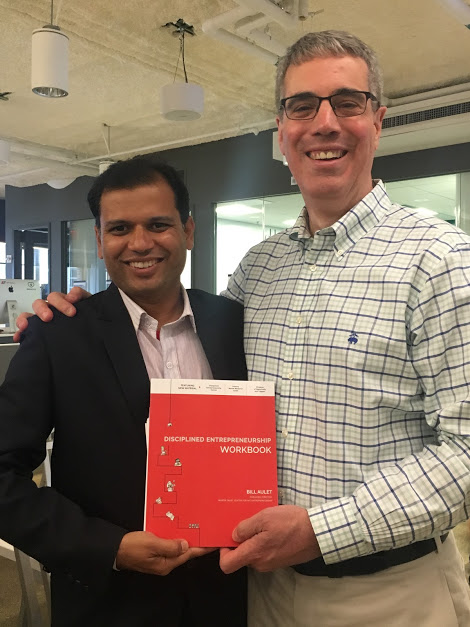Yes, entrepreneurship is chaotic. And can be organized too!
Zoom in to the poster below to check “24 steps to successful Startups” through philosophy of “Disciplined Entrepreneurship” by Bill Aulet (Managing Director, Martin Trust Center for MIT Entrepreneurship)


Yes, entrepreneurship is chaotic, And can be organized too. It can be much more disciplined with the help of integrated, comprehensive and proven framework. Bill Aulet’s book “Disciplined Entrepreneurship” is all about that. He is a practicing entrepreneur and Managing Director, Martin Trust Center for MIT Entrepreneurship at Massachusetts Institute of Technology. He talks about “24 steps to a successful startup” actually starts with step zero is a set of checklist and tools which will help you stay on track to build successful business from your ideas.
Step 0: Getting started
There are three starting points for entrepreneurship: a technology, idea, or passion. If you have a passion but no specific idea or technology, do some introspection to figure out the best use of your knowledge, skills, connections, financial assets, and work experience.
Step 1: Market segmentation
To segment your market, start by brainstorming possibilities. Your target should include not just the industry, but the specific type of user, their location, and other characteristics – e.g., 25- to 34-year-old men in Boston who play video games at night. Your best bet is to go after a new market, rather than trying to sell to everyone or snag part of a huge market.
Then, narrow the list down to 6-12 markets based on whether those customers have money and a reason to spend it, whether you can reach them and beat the competition, what possibilities they open up in other markets, and your interest in them. Finally, do research on those markets by talking to customers and observing them, making sure to be open to new information and not selling them on your solution. This process should take at least a few weeks.
Step 2: Select a beachhead market
To select a beachhead market, use the same criteria as before: whether those customers have money and a reason to spend it, whether you can reach them and beat the competition, what possibilities it opens up in future markets, and your interest in it. Smaller markets tend to be better, and it’s crucial that you pick just one and ignore the others (for now). Then, further segment your chosen market until it meets these conditions: customers buy similar products for similar reasons, and they talk to each other (for word of mouth).
Step 3: Build an end user profile
To profile the end user – who isn’t necessarily the buyer – narrow them down to a specific demographic, including things like age, location, income, habits, backstory, and motivations. It’s ideal if a founder, or at least an employee, fits into this category.
Step 4: Calculate the total addressable market (TAM) size for the beachhead market
The TAM is the amount of annual revenue you could earn if you achieved 100 percent market share, which equals number of users times revenue. Calculate number of users using bottom-up (customer lists, trade associations) and top-down methods (market reports) to verify. Calculate estimated revenue based on what your customers spend already and how much value you’re providing. You should aim for a TAM of $20-100 million; if it’s more than that, you need to segment further.
Step 5: Profile the persona for the beachhead market
Choose a real person to be your Persona and develop a description of them, including their photo, backstory, job, salary, purchasing criteria (in order), and many other details. Get the whole team involved in this process. The goal is to help you settle questions in the future about your customer, how to sell to them, which direction to take, etc.
Step 6: Full life cycle use case
Describe not just how your Persona uses your product, but how they discover a need for it, find out about it, analyze it, acquire it, install it, get value from it, pay for it, get support for it, buy more of it, and tell others about it.
Step 7: High-level product specification
Create a visual representation of your product: storyboards or wireframes for your website, or diagrams for your device. But don’t build anything yet or get too specific – the goal here is simply to iron out disagreements and misunderstandings among the team. Then, create a brochure that focuses on features and, more importantly, how they benefit the customer.
Step 8: Quantify the value proposition
Make a diagram that shows the status quo as well as the quantitative benefit the customer gets out of your product – in time, money, or whatever their top priority is. Use real numbers. Err on the side of underpromising and overdelivering.
Step 9: Identify your next 10 customers
Try to identify 10 customers who are similar to your Persona and willing to buy. You do this by actually talking to them and trying to validate your full lifecycle use case, product specification, and quantified value proposition. If they’re on board with everything, then you can ask for a commitment to buy; if not, go back to the drawing board and revise your assumptions. (That’s part of the process; after all, your assumptions are only estimates.) If you have tried and tried and can’t find 10 customers, it’s possible you need to change your Persona or even look into a new beachhead market.
Step 10: Define your Core
Explain your Core – your “secret sauce” that competitors can’t duplicate easily. It will become the focus of your efforts and shouldn’t change very much. It might be the network of users you’ve built up, fantastic customer service, low cost, or user experience. It usually isn’t your intellectual property, speed of innovation, first-mover advantage, or exclusive contracts with suppliers.
Step 11: Chart your competitive position
Make a competitive positioning chart: a two-dimensional graph that plots the customer’s top two priorities on either axis. Put yourself and your competition (including “the status quo”) on the map – you should be in the top right corner. And make sure your competitive position makes use of your Core – if not, you may need a different market opportunity.
Step 12: Determine the customer’s decision-making unit (DMU)
Map out all the people who influence the purchasing decision: from the end user to the primary buyer to champions, as well as other influencers, people with veto power, and the purchasing department (for B2B). You may have to learn to sell to or at least neutralize some of these other parties.
Step 13: Map the process to acquire a paying customer
Create a step-by-step timeline of how a customer will determine a need for your product, find out about it, analyze it, acquire it, install it, and pay for it. Estimate how long the sales cycle will be, and any big obstacles you might encounter in budget, regulations, or compliance.
Step 14: Calculate the TAM size for follow-on markets
Make a list of about five or six markets to enter after your beachhead market. They can involve selling other products to the same customers, or selling the same product to an adjacent market. Calculate their size the same way you did in Step 4, but without devoting as much time to it (maybe only 1/10 of the time). To raise money or build a big business, the overall TAM of your beachhead and follow-on markets (less than 10) should be over $1 billion.
Step 15: Design a business model
A business model is how you extract value from customers, and entrepreneurs don’t spend enough time thinking about this. Take a look at existing business models, like subscriptions, upselling, advertising, transaction fees, and micropayments. Remember that freemium and “we’ll figure it out later” aren’t business models. Then, brainstorm your own innovative model, and pick a good one – it’s hard to change later.
Step 16: Set your pricing framework
Estimate a price based not on your costs, but on the value you provide – a good estimate is around 20 percent of that value. Also take into consideration key prices in the DMU (like budget caps) and the price of your competitors’ products. Remember that you can offer different prices to different customers, and make sure to give discounts to early testers or influencers. Finally, it’s better to have a high price and lower it later than vice versa.
Step 17: Calculate the lifetime value (LTV) of an acquired customer
Calculate the LTV based on revenue streams, gross margins, retention rates, the life of the product, rate of re-purchasing, and the cost of raising funding. The last is crucial and expensive: startups pay a lot in equity in order to raise money. You’ll discover that factors like your business model, gross margins, retention rates, and ability to upsell have a large effect on your LTV.
Step 18: Map the sales process to acquire a customer
Figure out how the sales process will work in the short, medium, and long term. In the short term, you are generating demand on your own, often using salespeople or inbound marketing, email, and social media. In the medium term, orders flow in regularly and you can focus more on retaining existing customers; you may use distributors at this stage. In the long term, you’re mostly focused on client management.
Step 19: Calculate the cost of customer acquisition (COCA)
COCA is hard to calculate and perennially underestimated but crucially important, as a too-high COCA can kill a business. Calculate COCA from the top down: your overall sales and marketing costs divided by the number of customers you acquired during that time. To reduce your COCA, think about reducing direct sales, automating customer acquisition, improving conversion rates and lead quality, decreasing the sales cycle, and generating word of mouth.
Step 20: Identify key assumptions
Brainstorm your 5-10 top assumptions that haven’t been tested.
Step 21: Test key assumptions
Design the cheapest, quickest, easiest tests you can think of to refute or validate your key assumptions.
Step 22: Define the minimum viable business product (MVBP)
An MVBP is something that the customer gets value out of, pays for, and can provide feedback on. It should be testing your most key assumptions. The MVBP is further along that the lean startup methodology’s “MVP.”
Step 23: Show that “the dogs will eat the dog food”
Take your MVBP to customers and show that they will buy it, get engaged with it, and recommend it to their friends. Track metrics on all of these.
Step 24: Develop a product plan
Take some time to plan what features you’ll add to the MVBP for your beachhead market, and what adjacent markets you’ll enter next (and how you’ll have to adapt the product for them). Don’t spend too much time on this – the idea is simply to think about your options.
Being entrepreneur for last 20 years, I liked things being chaotic. In fact, entrepreneurs like us – that’s exactly the opportunity we always look for. However our own journey to simplify those complexities could be much more organized. Entrepreneurs are like athletes, certain guidelines can helps us to save some energy. I hope you agree with me that having known and unknown is a big difference. I highly recommended this book “Disciplined Entrepreneurship” by Bill Aulet to all practicing entrepreneurs and aspiring ones.
– Sunil Khandbahale, MIT Sloan Fellow, Innovator & Entreprenuer

